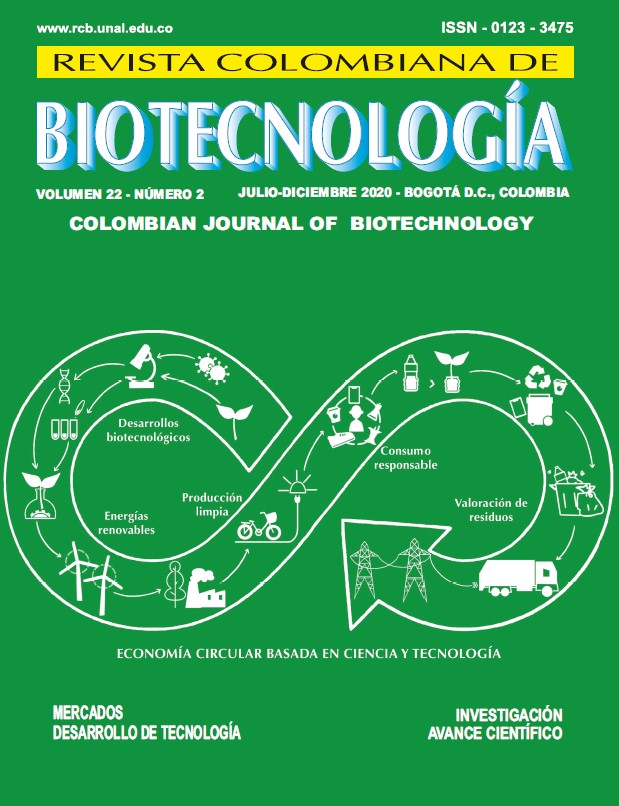Selection of somaclonal variants of maracuyá (passiflora Edulis var Flavicarpa. Deneger) tolerants to water deficit
Selección de variantes somaclonales de maracuyá (Passiflora edulis var flavicarpa. Deneger) tolerantes a déficit hídrico
SELEÇÃO IN VITRO DE VARIANTES SOMACLONAIS DE MARACUYÁ (Passiflora edulis var flavicarpa, Deneger) TOLERANTE AO DÉFICIT ÁGUA.
DOI:
https://doi.org/10.15446/rev.colomb.biote.v22n2.79623Palabras clave:
genetic variability, callogenesis, water stress, genetic improvement (en)variabilidade genética, calogênese, estresse hídrico, melhoramento genético. (pt)
variabilidad genética, callogénesis, estrés hídrico, mejoramiento genético. (es)
Climate change will have an impact on the Colombian agricultural sector, by 2050 increases in temperature and distribution of erratic rainfall are expected. Passion fruit cultivation does not tolerate water deficit, it reduces flower induction, generates fruit drop and defoliation. To tackle this problem, somaclonal variants (VS) of passion fruit were selected in-vitro, seeking tolerance to water deficit. Four phases were developed: I) callogenesis, II) direct and indirect organogenesis, II) Induction and evaluation of the water deficit with Polyethylene glycol 6000 (PEG 6000) and IV) in vitro selection of VS by morphometric measurements, chlorophyll and total sugars contents. Differences in callogenesis were found with different concentrations of 2,4-D, the concentration of 2 mg • L-1 presented better results producing calluses in less time and in greater quantity (8 days, 90% of the leaf area). In indirect and direct organogenesis the medium MS + ANA + BAP (0.3: 0.6), showed significant statistical differences with respect to other means, for the variables root length (15.14 cm), stem (16.72 cm) and leaves ( 14.51 cm) and root thickness (0.76 cm) stem (1.25) and leaf width (6.75). The influence of PEG 6000 showed significant differences, the treatment with 30 g • L-1 showed the smallest leaf width, the greatest width was found in 25 g • L-1. Statistical differences were found in chlorophyll levels and total sugar contents, the highest contents were recorded in the VS 25VS1, showing the possibility of obtaining seedlings tolerant to the water deficit of passion fruit by inducing somaclonal variation.
El cambio climático tendrá impactos en el sector agropecuario colombiano, para el 2050 se prevén aumentos de temperatura y distribución de lluvias erráticas. El cultivo de maracuyá no tolera el déficit hídrico, este disminuye la inducción floral, genera caída de frutos y defoliación. Para abordar esta problemática se seleccionaron in-vitro variantes somaclonales (VS) de maracuyá, buscando tolerancia al déficit hídrico. Se desarrollaron cuatro fases: I) callogénesis, II) organogénesis directa e indirecta, III) Inducción y evaluación del déficit hídrico con Polientilenglicol 6000 (PEG 6000) y IV) selección in vitro de VS por mediciones morfométricas, contenidos de clorofila y azúcares totales. Se hallaron diferencias en callogénesis con diferentes concentraciones de 2,4-D, la concentración de 2 mg·L-1 presentó mejores resultados produciendo callos en menor tiempo y en mayor cantidad (8 días, 90% del área foliar); en organogénesis indirecta y directa el medio MS + ANA + BAP (0.3:0.6), mostró diferencias estadísticas significativas respecto a otros medios, para las variables longitud de raíz (15.14 cm), tallo (16.72 cm) y hojas (14.51 cm) y grosor de raíz (0.76 cm) tallo (1.25) y ancho de hojas (6.75). La influencia de PEG 6000 mostró diferencias significativas, el tratamiento con 30 g·L-1 mostró menor ancho de hojas, el mayor ancho se encontró en 25 g·L-1. Se hallaron diferencias estadísticas en niveles de clorofila y contenidos de azúcares totales, los mayores contenidos se registraron en el VS 25VS1, mostrando la posibilidad de obtener plántulas tolerantes al déficit hídrico de maracuyá mediante la inducción de variación somaclonal.
Referencias
Albiski, F., Najla, S., Sanoubar, R., Alkabani, N., & Murshed, R. (2012). In vitro screening of potato lines for drought tolerance. Physiology and Molecular Biology of Plants, 18(4), 315-321. Disponible en: https://doi.org/10.1007/s12298-012-0127-5
Araus, J. L., & Kefauver, S. C. (2018). Breeding to adapt agriculture to climate change: affordable phenotyping solutions. Current Opinion in Plant Biology, 45(Pt B), 237-247. Disponible en: https://doi.org/10.1016/j.pbi.2018.05.003
Carr, M. K. V. (2013). The water relations and irrigation requirements of passion fruit (Passiflora edulis sims): a review. Experimental Agriculture, 49(4), 585-596. Disponible en: https://doi.org/10.1017/S0014479713000240
Castañeda-Castro, O., Gómez-Merino, F. C., Trejo-Téllez, L. I., & Pastelín-Solano, M. C. (2015). Osmotic stress induced by polyethylene-glycol alters macronutrient concentrations in sugarcane (Saccharum spp.) Plants in vitro. Agrociencia, 49(8). Disponible en: http://www.redalyc.org/resumen.oa?id=30243055004
Cauz-Santos, L. A., Munhoz, C. F., Rodde, N., Cauet, S., Santos, A. A., Penha, H. A., et al. (2017). The Chloroplast Genome of Passiflora edulis (Passifloraceae) Assembled from Long Sequence Reads: Structural Organization and Phylogenomic Studies in Malpighiales. Frontiers in Plant Science, 8. Disponible en: https://doi.org/10.3389/fpls.2017.00334
Cerqueira-Silva, C. B. M., Jesús, O. N., Santos, E. S. L., Corrêa, R. X., & Souza, A. P. (2014). Genetic Breeding and Diversity of the Genus Passiflora: Progress and Perspectives in Molecular and Genetic Studies. International Journal of Molecular Sciences, 15(8), 14122-14152. Disponible en: https://doi.org/10.3390/ijms150814122
Chachar, M. H., Chachar, N. A., Chachar, S. D., Chachar, Q. I., Mujtaba, S. M., & Yousafzai, A. (2014). In-vitro screening technique for drought tolerance of wheat (Triticum aestivium L.) genotypes at early seedling stage. 10, 12.
Claro, M. de L., Rodrigues, G. P., & Teixeira, S. A. (2018). Functional properties of yellow passion fruit bark (Passiflora edulis) in metabolic syndrome/Propriedades funcionais da casca do maracuja amarelo (Passiflora edulis) na sindrome metabolica. Recuperado 18 de abril de 2019, de Demetra: Food, Nutrition & Health website. Disponible en: http://link.galegroup.com/apps/doc/A570045921/AONE?sid=googlescholar DOI: https://doi.org/10.12957/demetra.2018.28957
Departamento Administrativo Nacional de Estadística. (2016). Encuesta Nacional Agropecuaria por departamentos. Disponible en: https://www.dane.gov.co/index.php/estadisticas-por-tema/agropecuario/encuesta-nacional-agropecuaria-ena/encuesta-nacional-agropecuaria-por-departamentos
Díaz V, Y., Lazo R, H. O., Portilla Ll, J. P., Ponce-Soto, L. A., & Marangoni, S. (2012). Respuesta fisiológica al déficit hídrico in vitro y análisis proteómico preliminar en callos de cuatro cultivares de Allium cepa L. (cebolla). Idesia (Arica), 30(3), 11-21. Disponible en: https://doi.org/10.4067/S0718-34292012000300002
Díaz Valencia, P. A. (2016). Repositorio institucional UN (Masters, Universidad Nacional de Colombia - Sede Medellín). Disponible en: http://www.bdigital.unal.edu.co/51030/
Dubois, M.,. (1956). Colorimetric method for determination of sugars and related substances. Analytical chemistry, 28(3), 350-356. DOI: https://doi.org/10.1021/ac60111a017
Eslami, M., Ahmadikhah, A., Azimi, M.-R., & Saeidi, A. (2018). Differential response of an international rice («Oryza sativa» L.) collection to drought simulated stress (PEG) at vegetative stage. Australian Journal of Crop Science, 12(6), 855. DOI: https://doi.org/10.21475/ajcs.18.12.06.PNE545
Fischer, G., & Casierra-Posada, F. (2009). Ecofisiología de las especies pasifloráceas cultivadas en Colombia. 24.
García, L. R., Leiva-Mora, M., Pérez, A. C., Collado, R., Martínez, I. P., Veitía, N. et al. (2015). Efecto del estrés hídrico inducido con PEG 6000 sobre la germinación in vitro de semillas de Phaseolus vulgaris L. cv. ‘ICA Pijao’. Biotecnología Vegetal, 15(4). Disponible en: https://revista.ibp.co.cu/index.php/BV/article/view/502
George, S., Jatoi, S. A., & Siddiqui, S. U. (2013). Genotypic differences against peg simulated drought stress in tomato. Pakistan Journal of Botany, 45(5), 1551-1556.
Herrera Flores, T. S., Ortíz Cereceres, J., Delgado Alvarado, A., & Acosta Galleros, J. A. (2012). Crecimiento y contenido de prolina y carbohidratos de plántulas de frijol sometidas a estrés por sequía. Revista mexicana de ciencias agrícolas, 3(4), 713-725. DOI: https://doi.org/10.29312/remexca.v3i4.1425
Kumar, T., Uzma, Khan, M. R., Abbas, Z., & Ali, G. M. (2014). Genetic improvement of sugarcane for drought and salinity stress tolerance using Arabidopsis vacuolar pyrophosphatase (AVP1) gene. Molecular Biotechnology, 56(3), 199-209. Disponible en: https://doi.org/10.1007/s12033-013-9695-z
Lau, C., Jarvis, A., & Ramírez Villegas, J. (2011). Agricultura Colombiana: adaptación al cambio climático. Disponible en: https://cgspace.cgiar.org/handle/10568/57475
Ma, Y., Wang, L., Wang, J., Zhong, Y., & Cheng, Z.-M. (Max). (2019). Isolation and expression analysis of Salt Overly Sensitive gene family in grapevine (Vitisvinifera) in response to salt and PEG stress. PLOS ONE, 14(3), e0212666. Disponible en: https://doi.org/10.1371/journal.pone.0212666
Manjarrés-Hernández, E. H., & Perea-Dallos, M. (2012). Establishment of a purple passion fruit (Passiflora edulis Sims.) propagation protocol from zygotic embryos and axillary shoots. Agronomía, 20(2), 53-64.
Marssaro, A. L., Morais-Lino, L. S., Cruz, J. L., Ledo, C. A. da S., Santos-Serejo, J. A. dos, Marssaro, A. L., et al. (2017). Simulation of in vitro water deficit for selecting drought-tolerant banana genotypes. Pesquisa Agropecuária Brasileira, 52(12), 1301-1304. Disponible en: https://doi.org/10.1590/s0100-204x2017001200021
Medina Gonzalez, G. (2014). Organogénesis directa in vitro de Nicotiana tabacum -variedad criollo Havanensis- a partir de láminas foliares. Disponible en: https://bdigital.zamorano.edu/handle/11036/3498
Moreno-Bermúdez, L. J., Reyes, M., Rodríguez, M., Kosky, R. G., Roque, B., & Chong-Pérez, B. (2017). Respuesta de cultivares de Musa spp. al estrés hídrico in vitro inducido con polietilenglicol 6000. Revista Colombiana de Biotecnología, 19(2), 75-85. Disponible en: https://doi.org/10.15446/rev.colomb.biote.v19n2.60405
Munhoz, C. F., Costa, Z. P., Cauz-Santos, L. A., Reátegui, A. C. E., Rodde, N., Cauet, S., et al. (2018). A gene-rich fraction analysis of the Passiflora edulis genome reveals highly conserved microsyntenic regions with two related Malpighiales species. Scientific Reports, 8(1), 13024. Disponible en: https://doi.org/10.1038/s41598-018-31330-8
Murashige & Skoog, S. (1962). A Revised Medium for Rapid Growth and Bio Assays with Tobacco Tissue Cultures - Murashige - 1962 -. Disponible en: https://onlinelibrary.wiley.com/doi/pdf/10.1111/j.1399-3054.1962.tb08052.x
Naser, L., Kourosh, V., Bahman, K., & Reza, A. (2010). Soluble sugars and proline accumulation play a role as effective indices for drought tolerance screening in Persian walnut (Juglans regia L.) during germination. Fruits, 65(2), 97-112. Disponible en: https://doi.org/10.1051/fruits/20010005
Rai, M. K., Kalia, R. K., Singh, R., Gangola, M. P., & Dhawan, A. K. (2011). Developing stress tolerant plants through in vitro selection—An overview of the recent progress. Environmental and Experimental Botany, 71(1), 89-98. Disponible en: https://doi.org/10.1016/j.envexpbot.2010.10.021
Sánchez Chiang, N., & Jiménez, V. M. (2008). Técnicas moleculares para la detección de variantes somaclonales. Agronomía Mesoamericana, 20(1), 135. Disponible en: https://doi.org/10.15517/am.v20i1.4989
Schaller, G. E., Bishopp, A., & Kieber, J. J. (2015). The Yin-Yang of Hormones: Cytokinin and Auxin Interactions in Plant Development. The Plant Cell, 27(1), 44-63. Disponible en: https://doi.org/10.1105/tpc.114.133595
Sistema de información sobre biodiversidad de Colombia. (2018). Sistema de información sobre biodiversidad de Colombia. Disponible en: https://ipt.biodiversidad.co/cr-sib/resource.do?r=2449_variacion_somaclonal_maracuya_20180502
Tsago, Y., Andargie, M., & Takele, A. (2014). In vitro selection of sorghum (Sorghum bicolor (L) Moench) for polyethylene glycol (PEG) induced drought stress. Plant Science Today, 1(2), 62-68. Disponible en: https://doi.org/10.14719/pst.2014.1.2.14
Verma, D., Ansari, M. W., Agrawal, G. K., Rakwal, R., Shukla, A., & Tuteja, N. (2013). In vitro selection and field responses of somaclonal variant plants of rice cv PR113 for drought tolerance. Plant Signaling & Behavior, 8(4), e23519-e23519. Disponible en: https://doi.org/10.4161/psb.23519
Vijayakumari, K., & Puthur, J. T. (2016). γ-Aminobutyric acid (GABA) priming enhances the osmotic stress tolerance in Piper nigrum Linn. plants subjected to PEG-induced stress. Plant Growth Regulation, 78(1), 57-67. Disponible en: https://doi.org/10.1007/s10725-015-0074-6
Cómo citar
APA
ACM
ACS
ABNT
Chicago
Harvard
IEEE
MLA
Turabian
Vancouver
Descargar cita
CrossRef Cited-by
1. Lourival Ferreira Cavalcante, Lucas Victor da Luz César, Antônio Gustavo de Luna Souto, Jamiles Carvalho Gonçalves de Souza Henrique, Ítalo Herbert Lucena Cavalcante, Lucas Henrique Maciel de Carvalho, Francisco Éder Rodrigues de Oliveira, Geovani Soares de Lima, Lauter Silva Souto, Hans Raj Gheyi. (2025). Mineral Nutrition and Yield of Irrigated Sour Passion Fruit as Influenced by an Alternative Organic Source, Sisal Shredding Residue. Applied Fruit Science, 67(5) https://doi.org/10.1007/s10341-025-01593-3.
Dimensions
PlumX
Visitas a la página del resumen del artículo
Descargas
Licencia
Derechos de autor 2020 Revista Colombiana de Biotecnología

Esta obra está bajo una licencia internacional Creative Commons Atribución 4.0.
Esta es una revista de acceso abierto distribuida bajo los términos de la Licencia Creative Commons Atribución 4.0 Internacional (CC BY). Se permite el uso, distribución o reproducción en otros medios, siempre que se citen el autor(es) original y la revista, de conformidad con la práctica académica aceptada. El uso, distribución o reproducción está permitido desde que cumpla con estos términos.
Todo artículo sometido a la Revista debe estar acompañado de la carta de originalidad. DESCARGAR AQUI (español) (inglés).


















